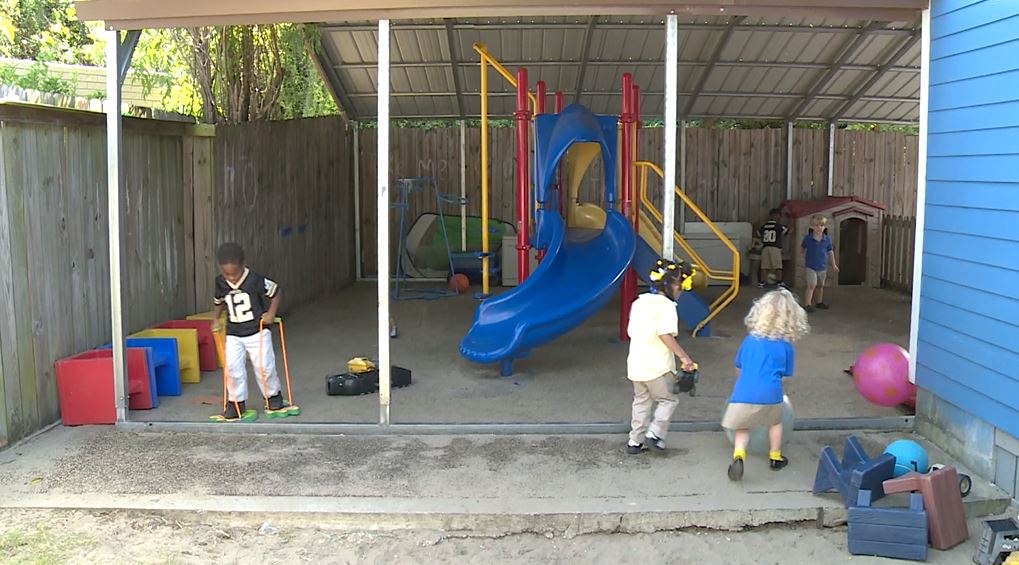NEW ORLEANS -- Giving children more time to move outdoors is associated with major health benefits. But did you know it also makes them l
earn better and improve their grades?
Big changes in the children happened when researchers made some small changes in local daycare centers, where children are sedentary nearly 90 percent of the time.
So Dr. Melinda Sothern and a team of registered dieticians from LSU Health Sciences Center did a study in 26 area centers. Slowly they taught the staff small changes in meals, like fruit -- not cake or cookies -- for dessert, and supervised outdoor play for physical activity.
"No sugary beverages. The children get water for thirst and they get milk for meals, which is what is recommended. Those are big changes. So if you can just get those changes in place, you really go a long way," said Dr. Melinda Sothern, an exercise and obesity expert and researcher in LSU's School of Public Health.
Outdoor, inexpensive movable equipment not only burned calories and energy, but taught cooperative play so they could learn sharing and fairness.
The change was not only scientifically measurable, but noticeable to the staff.
"We have a lot less behavior problems among the children. Really minimize, almost none. When the kids did lay down for nap, they were less restless. They were really more relax," said Kristi Givens, the owner and director of Kids of Excellence Child Development Center.
When children expend their natural energy, they sleep better, and sleep is when their muscles grow and repair. They have fewer symptoms of ADHD. They have fewer cases of obesity and diabetes, and sleep is when their brains commit what they've learned to long-term memory.
Dr. Sothern said children need 11 to 12 hours of sleep a day. That, and moving their bodies in space, makes them smarter with better grades.
"The children have to first learn it with their bodies before they can learn it with their minds," Dr. Sothern said about the relationship of children moving their arms and legs in space and the space between letters and words when reading.
And the pre-school children we spoke to see to like the change. In fact, among the three we talked to, it was unanimous.
"Purple grapes," said Clio Anderson when asked what she liked to eat.
"Watermelon," said Robin Hand.
When asked who likes to pedal the scooter on the bike trail they all raised their hands and yelled, "me!"
"I want to go outside and run around with my friends," Aiye Banks chimed in.
Here are the details of the study and the link to the free physical activity and nutrition program:
The Nutrition and Physical Activity Self-Assessment for Child Care (NAP SACC) program was developed to be used in preschool settings as a toolkit to promote healthy weight and help prevent childhood obesity. It was designed to facilitate gradual change and promote continuous quality improvement, and it is one of the few interventions that targets both physical activity and nutrition.
Although this program has generated interest, there had not been objective, well-designed scientific studies to evaluate and measure outcomes that would support policy decisions and implementation recommendations. Dr. Sothern's research team designed this study to determine objectively whether the
NAP SACC program would improve physical activity levels in randomly selected licensed Louisiana day care centers.
This study compared the physical activity levels of children in 26 day care centers, randomized into treatment and control groups. Of the 209 three–five-year-old children participating, 104 were male and 105 female. The children wore wireless activity monitors that captured data from 8:30 a.m. until 3:00 p.m. for two days before and immediately after a six-month intervention taking identical measurements. Pre-intervention results revealed that the children in both groups combined were sedentary 89.9% of the time.
Dieticians with physical activity training experience implemented the NAP SACC program by conducting workshops for the staff of each treatment facility with information on overweight, nutrition, physical activity and growing, healthy kids. They maintained regular contact with the treatment facility staff and provided support. They also distributed educational information to the parents/guardians focusing on physical activity and nutrition recommendations at home. Each treatment facility devised an improvement plan.
Total physical activity in the treatment group increased by 21.9% compared to 4.4% in the control group. Vigorous physical activity rose by 50% in the treatment group and 3.8% in the control group. Moderate physical activity in the treatment group improved by 32.7% compared to 0% in the control group. The control group showed no significant changes in physical activity and remained relatively unchanged.
"This study demonstrated that the Nutrition and Physical Activity Self-Assessment for Child Care program is a viable tool for increasing physical activity in children in day care," concludes Dr. Sothern. "Turn-key programs like this are beneficial to many daycare centers that do not have the resources to design, identify and implement the types of improvements that are necessary to address childhood obesity."
The NAP SACC program is available at http://www.centertrt.org/?p=intervention&id=1091.
The LSUHSC research team also included Marc Bonis, PhD, who implemented the physical activity measurements, Tung Sung Tseng, DrPH, and Ann Clesi, MS. Mark Loftin, PhD, of the University of Mississippi, and Dianne Ward, EdD, of the University of North Carolina Chapel Hill, rounded out the research team.
The study was funded by the Office of Public Health-Maternal and Child Health of the Louisiana Department of Health and Hospitals.


![daycare center [ID=16451943]](http://moc-assets-prod.gannett-cdn.com/-mm-/1121da4f1cb237492c4eb04ddbe29477fcca23e9/r=500x277/local/-/media/WWL/None/2014/09/29/1412031204000-daycare-center.JPG)
